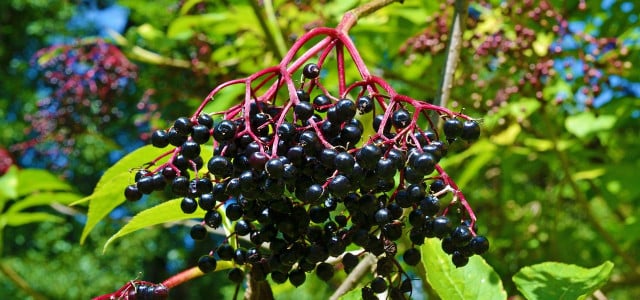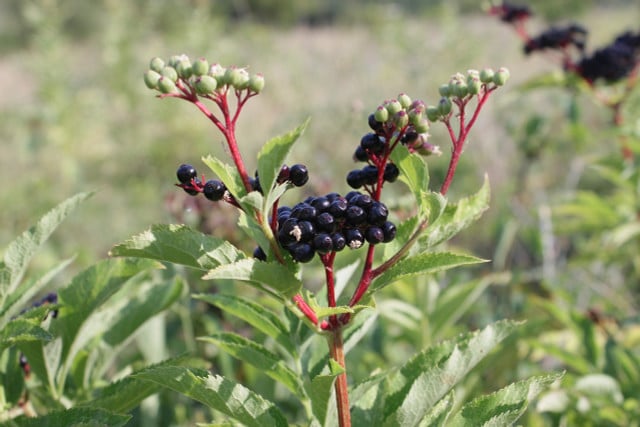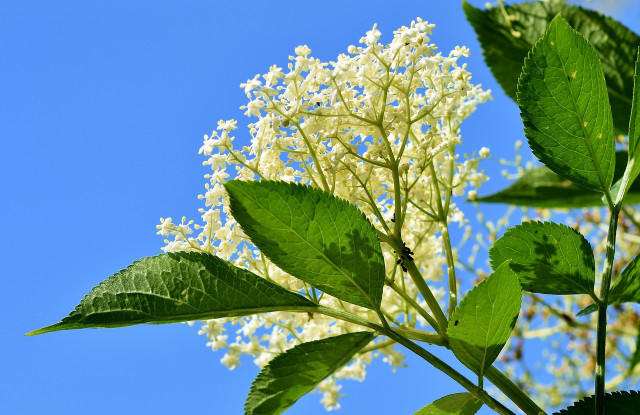
While they are in bloom, elderberry bushes are easily identified by their yellowish-white flowers. But did you know that there is a risk of confusion with elderberries? This way you can avoid poisoning.
When we talk about elderberry, we usually mean the black elderberry (Sambucus nigra). But there are also other types of elderberry and they can even be poisonous.
Here we describe in detail the difference between black elderberry, grape elderberry (Sambucus racemosa), also called red or mountain elderberry, and the dwarf elderberry (Sambucus ebulus), so that you don’t have to worry about the risk of confusion when collecting elderberries.
Danger of confusion with elderberries: The types of elderberries

(Photo: CC0 / Pixabay / byrev)
The three types of elderberry differ in their toxicity, with the dwarf elderberry being particularly dangerous and the black elderberry carrying the least risk.
-
Dwarf elderberry (Sambucus ebulus): All parts are highly poisonous, especially the seeds of the berries. Symptoms include nausea, vomiting and diarrhea. Poisoning can be fatal.
-
Grape elder (Sambucus racemosa): The flowers and berries are poisonous raw, the latter can be eaten cooked but in small quantities. Important: You must remove all seeds in the berries as their poison is not destroyed by heat.
-
Black elderberry (Sambucus nigra): The “normal” elderberry that is traditionally used for baked elderflowers or elderflower tea. Its berries can also cause discomfort when raw. You can use the cooked berries to make elderberry syrup or elderberry jelly, for example.
So be careful with raw elderberries: dwarf elderberries are always poisonous and you should also not eat the berries of grape and black elderberries raw.
Correctly distinguish between types of elderberry

(Photo: CC0 / Pixabay / Ralphs_Fotos)
The greatest risk of confusion with elderberries is between the black elderberry, whose flowers are even edible raw, and the dwarf elderberry, which is always poisonous. This is how you distinguish them:
shape and growth
- Dwarf elderberry grows rather herbaceously and its stems are filled with yellow, cork-like mass. It grows to a maximum height of around 1.50 meters.
- Black elderberry grows woody, more like a tree, and can grow up to six meters tall. The pith in the branches is white.
- Grape elderberry grows to a height of around two to four meters. It grows as a branched shrub. Noticeable: If you break off a branch, the open area stinks. That’s why it’s also called the “smelly elderberry”.
leaves
- Dwarf elderberry has leaves that grow pinnately in groups of seven to nine. They are reddish in spring and become greener in early summer. Their shape is rather elongated, pointed, they are widest at or below the middle. In addition, the leaves are weakly serrated.
- The leaves of black elderberry grow in groups of five to seven, also growing asymmetrically. The leaves are less pointed and elongated than the dwarf elderberry. It blooms in late May to early June.
- The leaves of the grape elder are also lanceolate, similar to those of the black elder, and often have a reddish tint.
blossoms
- The anthers of the dwarf elderberry are initially red and then turn black after a while. It blooms June to September, depending on the location.
- In the black elderberry, the anthers are pale yellow. The flower has the familiar plate shape.
- Is this how the grape elderberry got its name? The flowers grow upwards in the shape of an upside-down bunch of grapes. It blooms from late April to mid-May.
Berry
- Dwarf elderberry also has black berries, but they are more upright and have a small dent.
- The berries of the black elderberry hang down and are round, without dents.
- The berries of the grape elderberry turn bright red when they are ripe.
The probability of encountering dwarf elderberries is particularly high in southern to central Germany.
Be careful when collecting elderberries
As always, when collecting wild plants for consumption, exercise extreme caution. Don’t take anything with you that you aren’t sure what it is. It’s best to pick up a wild plant guide or take part in a tour where professionals accompany the collection. There you will not only get safety, but also tips on correct harvesting and processing.
Read more on Techzle\.com:
- Collecting berries: this is what nature offers now
- 4 edible wild plants you can collect in autumn
- Collecting, identifying and eating wild herbs: 11 tips